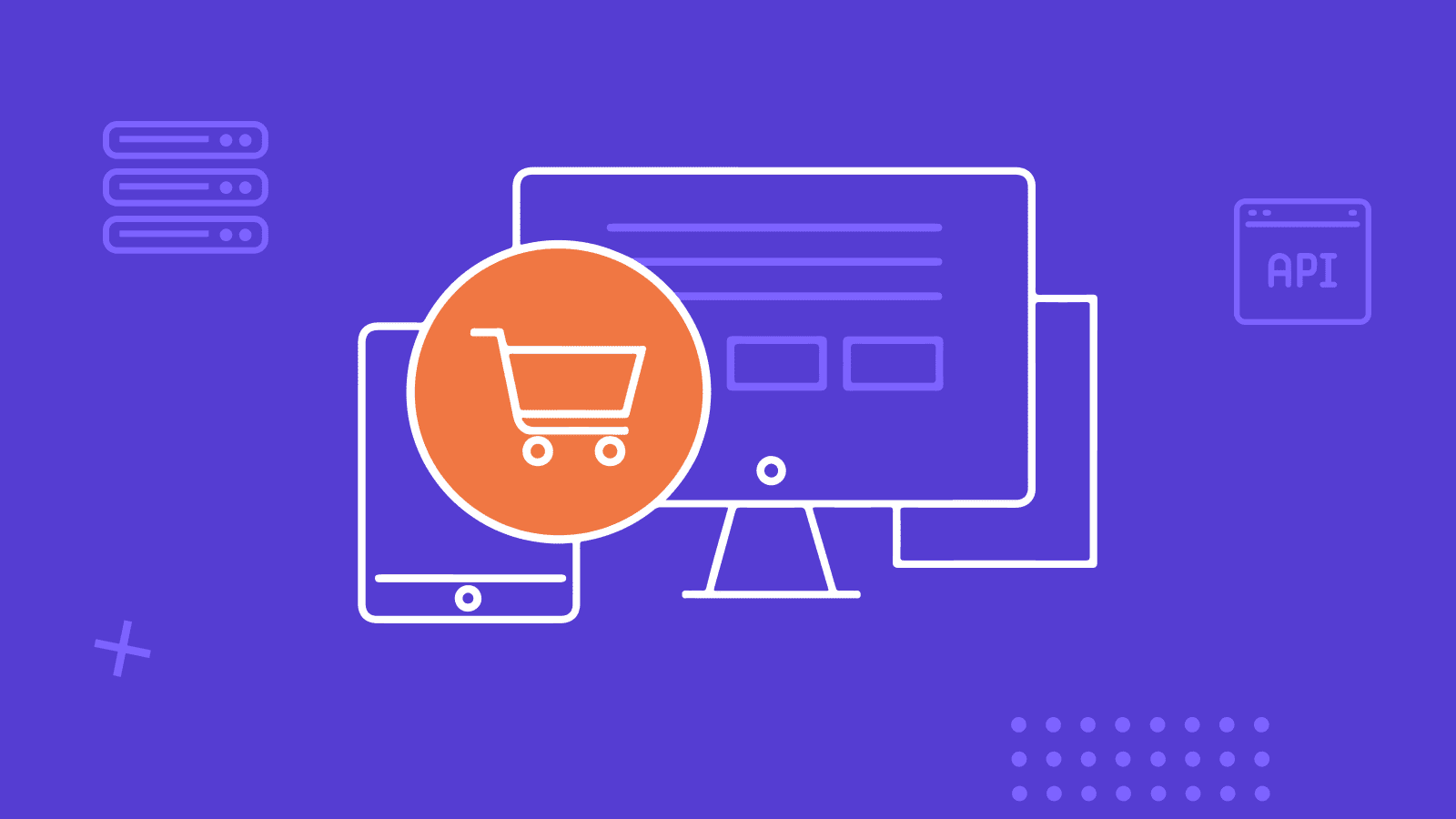By 2025, it’s estimated that eCommerce will make up 24.5% of all retail shopping worldwide. This includes everything from B2B to B2C retail sales.
To be competitive in the eCommerce space, the platform you use needs to be adaptive. You have to be able to change things as you see fit and not be tied to a coupled front-end and back-end system.
You should be able to make changes to the customer-facing side of your eCommerce store without having to touch the back-end store processes that control shopping carts, shipping orders, tax calculations, and more.
Similarly, you should be able to make adjustments to these back-end processes without impacting the front-end, where your customers interact with the store.
That’s where headless commerce platforms come into play. But with so many headless commerce platforms out there, you might not know where to start looking.
That’s why we’ve listed 12 of the very best headless commerce platforms in this guide, each with its own unique benefits. You can also use this ROI calculator, to find the true revenue impact on shifting to headless commerce.
But before we get into the best headless eCommerce platforms, let’s dive into the basics.
What Is a Headless Commerce Platform?
A headless commerce platform is a system that decouples the front end of an eCommerce platform from the back end.
As we briefly mentioned before, what we know as the “front end” of an eCommerce store is the customer-facing part, where shoppers interact. This includes your user interface, product pages, etc.
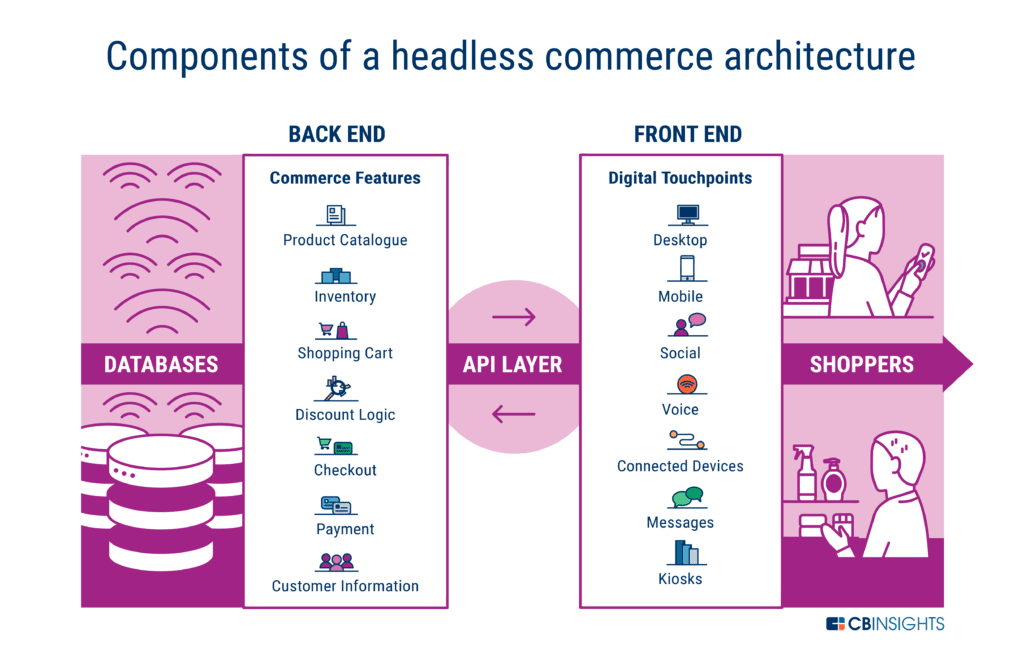
The back-end is where business logic is empowered to run the entire experience in ways that your customers never see. This includes all of the technical elements of your store, like the shopping cart system, order processing, checkout, shipping system, tax calculations, and more.
One of the top benefits of headless commerce is it offers a flexible solution for eCommerce teams that want to bring a unique approach to their store. ECommerce businesses often need to inspire a lot of confidence in prospects. That’s hard to do with a cookie-cutter shopping platform that’s stuck on rails.
Traditional eCommerce systems come with an experience that has been laid out entirely for both the shoppers and your administrative staff. However, headless eCommerce gives you the ability to break those chains and develop customizable experiences on both ends. That’s what makes it a freeing solution for companies that have felt tied down by traditional eCommerce templates in the past.
When using a headless eCommerce system, you’ll find it far easier to meet needs that are unique to your brand. When the front and back ends of a store are coupled together, you have to work around the existing front-end design on different platforms and devices.
However, native headless commerce platforms, which were created specifically to be headless, can be used by companies of all sizes to easily deliver highly customized experiences that render perfectly on any device by leveraging ecommerce APIs.
There are certainly advantages to using these native platforms, but they’re not the only way to achieve a headless commerce architecture. Traditional commerce systems that weren’t built to be headless might still support this decoupling process. You just have to see how cleanly they adapt to headless support.
What Should You Look for in a Headless Commerce Platform?
Now that you have a strong understanding of what a headless commerce platform is, it’s time to dig down into what you should be looking for when shopping around for one.
There are many headless commerce platforms out there, which means your choice isn’t always straightforward. It would be easy to buy into the marketing hype behind these eCommerce systems and invest in one only to find that it doesn’t offer everything you were hoping for.
Here are a few factors you should consider before purchasing a headless commerce system.
What’s the User Interface Like?
When looking for a headless commerce platform, you want to find a user interface free of clutter. It should be nice and neat, without a steep learning curve. Your eCommerce system is the heart and soul of your entire operation, so you need to ensure that you aren’t going to get a headache every time you look at the back-end.
You also need to ensure that the front-facing user interface is equally clean. While you might take some time to train yourself in using this system, your shoppers will not be anywhere near as patient.
What Kinds of Integrations are Available?
Can your headless commerce platform connect easily with other tools you use day in and day out? It should be able to, at the very least, connect with your customer relationship management (CRM) and product information management (PIM) tool, where all of your customer and product data are stored.
Is it easy to learn the platform?
Does the service have a knowledge base with tutorials? Is it easy to access and understand? Are there how-to videos walking you through frequently asked questions and problems you might encounter? Is there API documentation walking you through this vital component?
A community forum where users help one another out and provide actionable advice is another great resource to look out for.
Is It Customizable?
Part of the job of a decoupled commerce system is personalization. You can customize both the front and back ends of your platform, independent of one another. But how far does that personalization go?
If you already have tools that are integral to your business, ensure that you can connect them. If you’re still shopping for these other tools, make a note of which integrations your headless commerce system includes and see if those tools meet your needs.
Does It Have Good Customer Support?
When it comes to something as crucial as your eCommerce platform, you need to make sure that the customer support offered by the parent company is stellar. That means 24/7 support via live chat, phone, and email.
If something goes wrong and your store goes down, you need to be able to reach someone to fix the issue as soon as possible. Every second that your store remains offline, you’re potentially losing money. Someone might come looking for your products, see that the store isn’t working, and head to one of your competitors instead.
Responsive, effective, 24/7 customer service is a 100% must-have.
Have an idea about what you want to see in your store regarding personalization, and keep those goals in mind when shopping for a headless commerce platform.
The 12 Best Headless Commerce Platforms
1. Shopify
Shopify is a huge name in the world of eCommerce. It’s a stable and secure platform with a huge app store
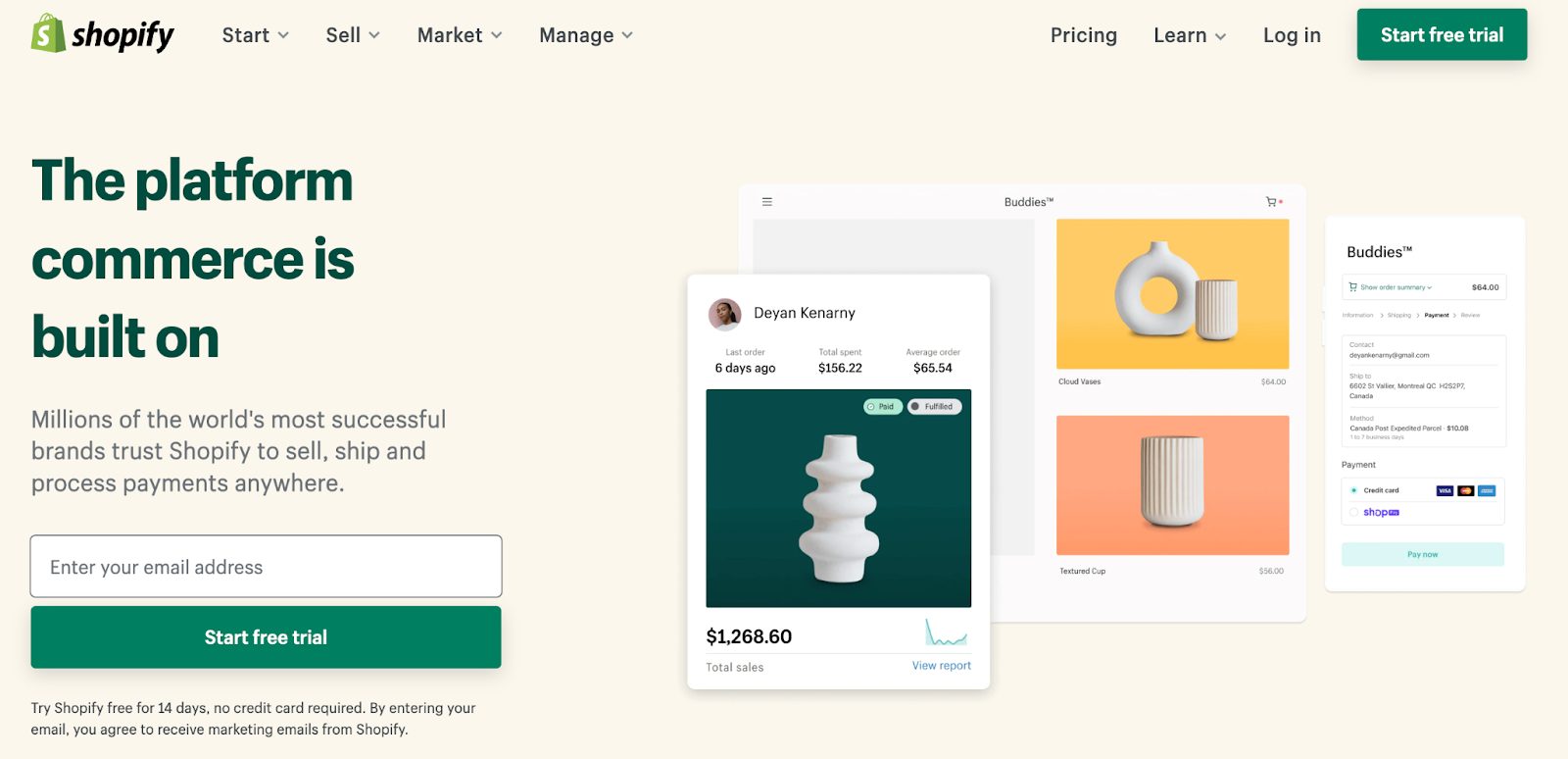
For a long time, Shopify was a standard eCommerce platform. However, its GraphQL API suddenly made it compatible with headless commerce through Shopify Plus, propelling it into the modern age and holding onto its place as one of the world’s most relevant and trusted platforms.
When using headless commerce as a part of Shopify Plus, you can publish to any channel with complete creative control along various touchpoints and devices.
You’re able to integrate all of the different systems that make your business run, including your CRM, PIM, CMS, and ERP, to name a few. There are apps for Google Sheets, Slack, Mailchimp, Apple Business Chat, and many other big-name services. You can also integrate with third-party marketplaces, including eBay and Amazon.
This platform is famous for stability, with an easy-to-use dashboard and an intuitive content management system.
Shopify offers a free trial, and regular plans start at $29 per month. The Shopify Plus SaaS enterprise-level service costs $2,000 per month. You can use a Shopify fees calculator to estimate the costs of using the platform, including transaction fees and credit card rates.
What’s the User Interface Like?
Shopify boasts a clean user interface with clearly defined menu options. It’s effective on both the back end and user-facing sides.
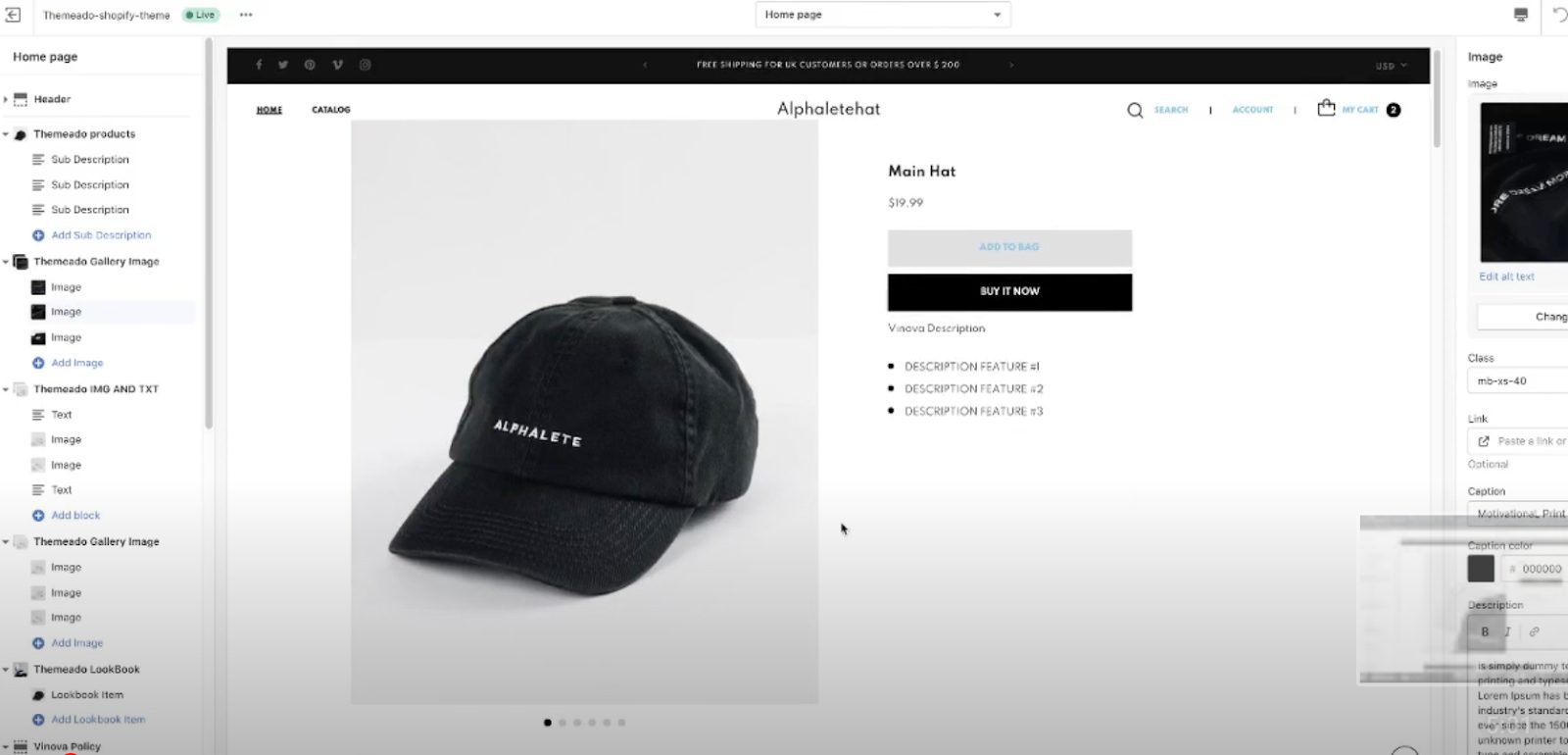
What Kinds of Integrations are Available?
Shopify integrates with various systems, including your CRM, PIM, CMS, and ERP. It also has apps for services like Google Sheets, Slack, Mailchimp, Apple Business Chat, and more. It even integrates with systems like eBay and Amazon.
Does it Have Good Customer Service?
Shopify has community forums, a help center, and also provides support by phone and live chat. A full help center is also available with a wealth of articles to choose from.
Is it Customizable?
Shopify Plus is a highly customizable service, allowing you to customize themes, products, checkouts, discounts, and payments.
Relevant read: Check out our ultimate guide on how to start a headless shopify store
2. Magento (Adobe Commerce)
Now known as Adobe Commerce, Magento is a highly customizable headless commerce platform. Web developers can create custom applications that fit the needs of their customers using this service. It also includes several omnichannel solutions stored on the cloud that make it easy to combine digital and brick-and-mortar shopping.
With the company’s famed inventory management system, you can track what you have in stock across all of your locations, including stores and warehouses, among others. This information is kept in real-time, so you’ll always have a strong sense of what’s available.
Magento is famous for its analytics, offering enhanced data visualization. Your data can be easily exported right to an inbox, providing insights into retention rates, lifetime value, and average order value over a chosen period.
Magento allows for custom integrations through the REST and SOAP web API frameworks. You can create CRM, CMS, PIM, ERP, accounting, marketing, and inventory management integrations, to name a few.
Pricing for Adobe Commerce is available upon request.
What’s the User Interface Like?
Magento has a clean user interface with a central dashboard and sidebar menu that allows you to access the core features of the service.
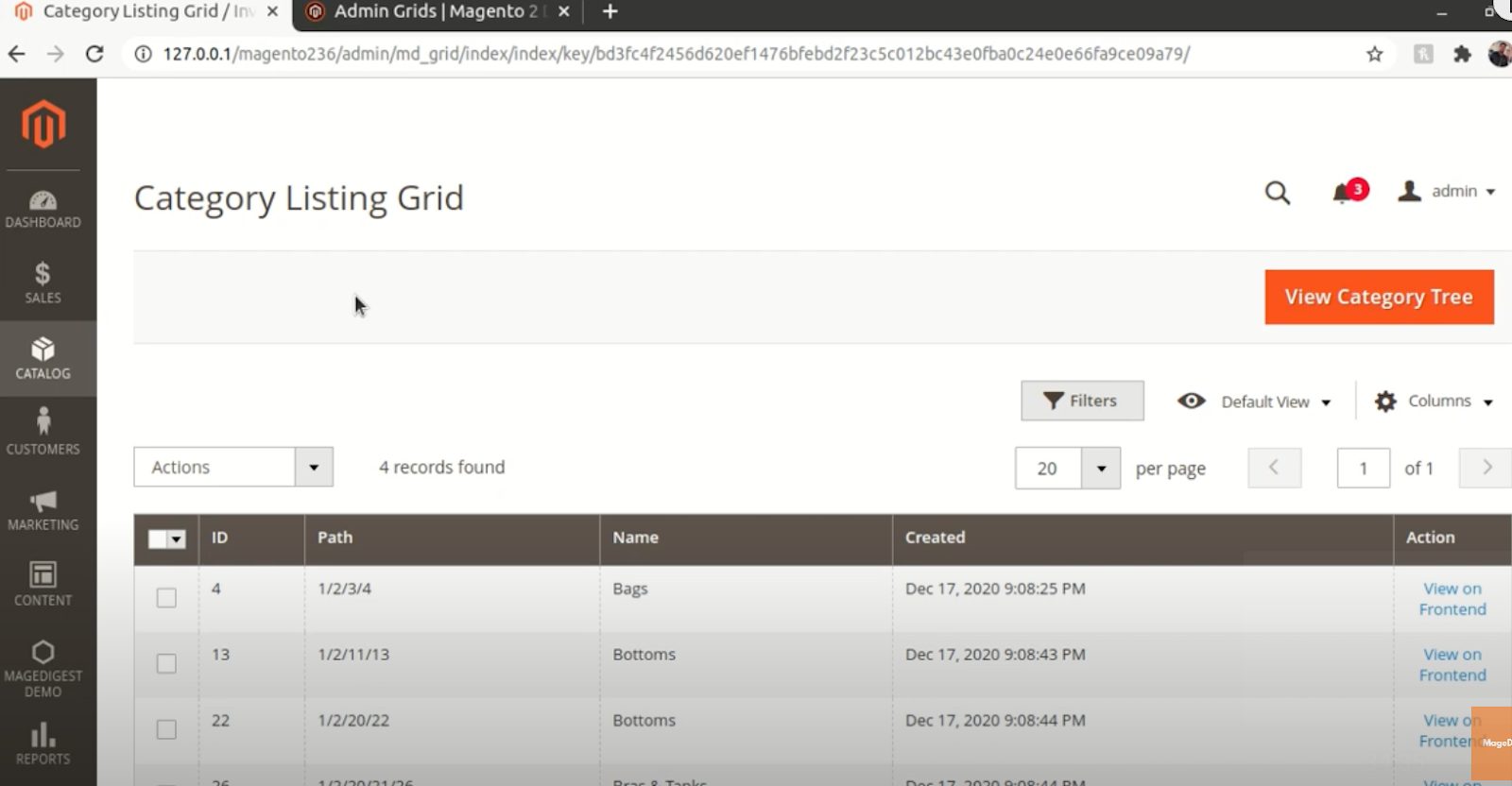
What Kinds of Integrations are Available?
You can create custom integrations with Magento using the REST and SOAP web API frameworks. This lets you create integrations for your CRM, PIM, ERP, CMS, marketing tools, inventory management, and accounting platform.
Does it Have Good Customer Service?
Adobe Commerce Help Center, offers a variety of support tools that help and empower you to improve your e-commerce store experience. Customers can also create a support ticket to address any specific issues. It also has a wealth of useful information and resources like best practices, diagnostic and monitoring tools, and the most relevant information about your site.
Is it Customizable?
Magento is highly customizable, but you might need advanced experience and development knowledge to get the most out of it.
3. BigCommerce
BigCommerce is another popular online eCommerce platform that offers headless commerce functionality. The commerce engine can be decoupled from the customer-facing user interface, allowing you to run various stores simultaneously across many different channels — all from one central location.
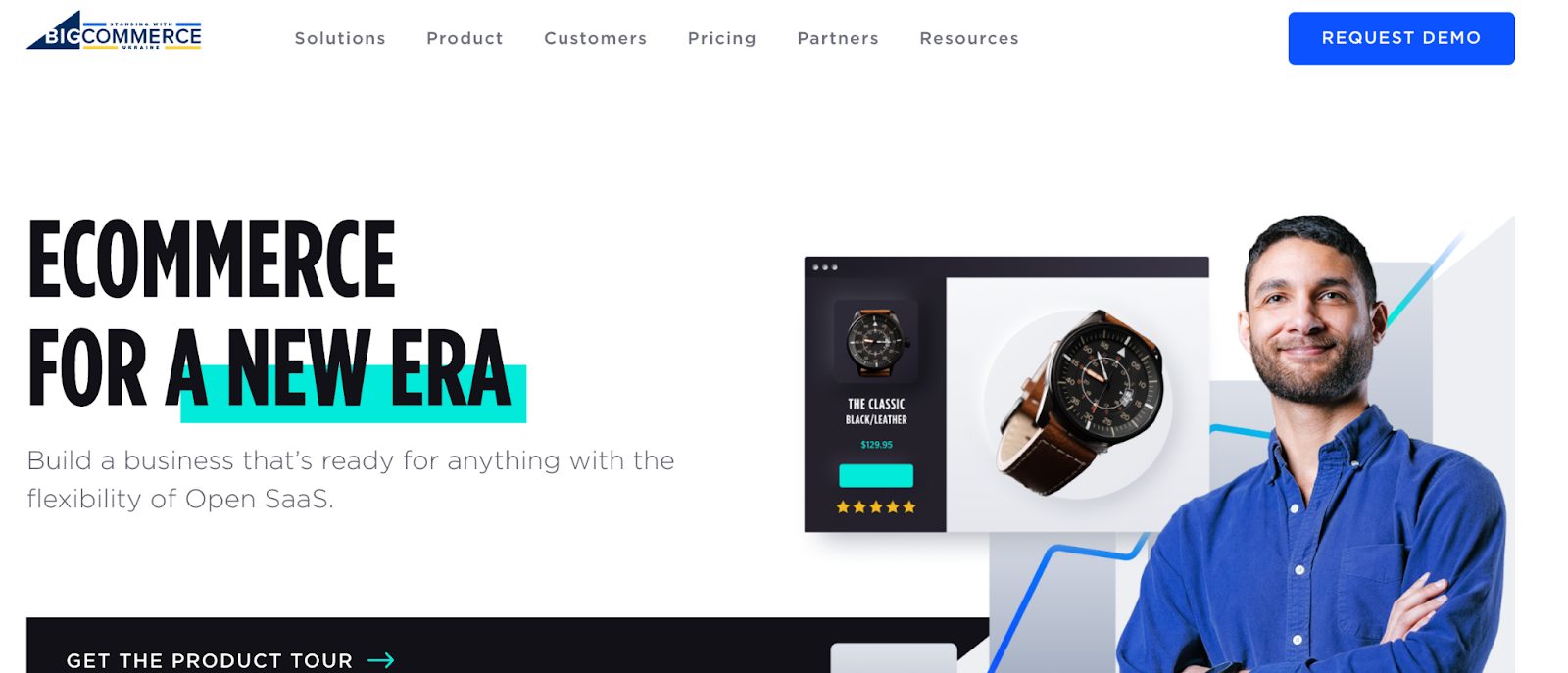
With BigCommerce, you’re getting enterprise-level functionality with top performance and an impressive app-based system. It’s used in both the B2B and B2C sectors. The system is designed for scaling businesses, allowing companies to grow at the pace they want.
When using BigCommerce, you can provide API-driven experiences using integrations and APIs for WordPress, eBay, Google, Stripe, Adobe Experience Manager, Drupal, Mailchimp, Amazon, etc. There’s also a popular BigCommerce WordPress plugin, making it more compatible with the world’s most popular CMS.
One benefit to BigCommerce over some of the other leading services in the industry is that it doesn’t throttle API calls.
BigCommerce offers a one-month free trial, and paid plans start at $29.95 per month.
Further Read: Everything you need to know about headless Bigcommerce
What’s the User Interface Like?
BigCommerce boasts a clean user interface with a Home screen that shows off your store’s sales metrics immediately. A side menu allows you to navigate the backend of your headless commerce site easily.
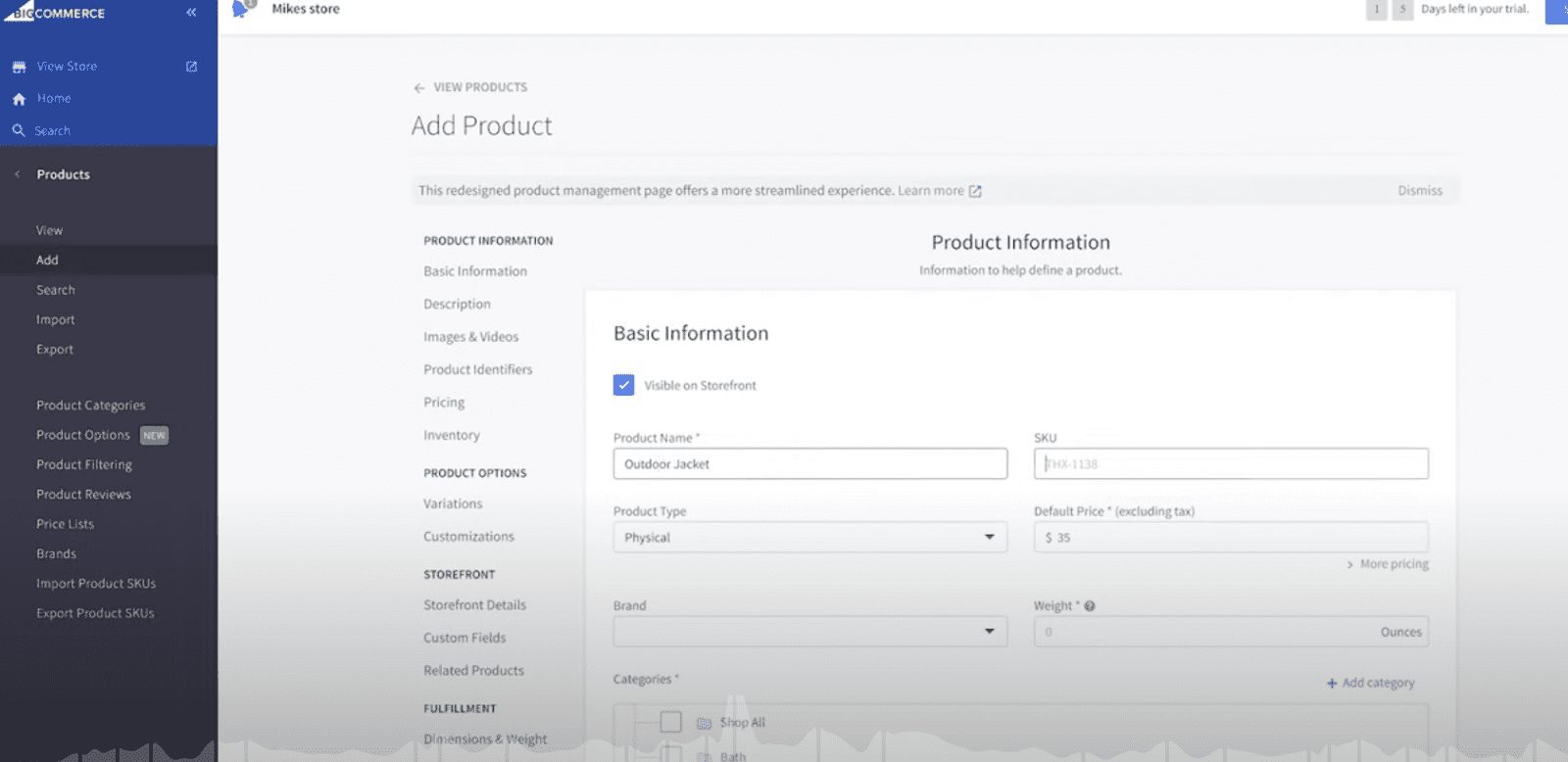
What Kinds of Integrations are Available?
BigCommerce has many integrations available, including WordPress, Google, eBay, Stripe, Drupal, Mailchimp, Amazon, and more. The BigCommerce for WordPress plugin helps you to leverage the best aspects of both platforms, allowing WordPress to manage content and BigCommerce to manage ecommerce.
Does it Have Good Customer Service?
BigCommerce has a useful help center with 24/7 live chat, phone, and email support. BigCommerce also offers a comprehensive knowledge base, featuring help articles and frequently asked questions, developer information, a community forum, and video tutorials.
Is it Customizable?
There are many apps that will allow you to customize your BigCommerce store fully. This includes:
- Klevu Search for adding a search function to your store
- ShipStation to customize your shipping and fulfillment options
- CoinPayments to accept cryptocurrency payment options
- Gorgias to add a help desk and live chat support
- And many more!
Relevant Read: Everything you need to know about creating a headless BigCommerce store
4. Commercetools
Headless commerce tech joins an omnichannel platform with Commercetools to offer cloud-based point of sale functions. It has become a popular option for both B2B and B2C companies.

Customers can use this service to provide eCommerce experiences across various touchpoints on a massive scale. This includes mobile apps, websites, VR applications, and even voice assistants. It does this through an API-driven approach that uncouples the front and back ends and allows users to design custom solutions.
What’s more, you won’t need any SQL or other customizations because the APIs cover everything. There’s also a wealth of inventory management features that will come in handy for stores of all sizes. This includes tracking, adjustments, multi-store management, and returns.
As far as integrations go, you can integrate Commercetools seamlessly with Cybersource (for payment management solutions), Contentstack (for content management), and Frontstatic (for frontend development). It’s also possible to integrate it with front-end CMS systems like Adobe Experience Cloud.
Commercetools doesn’t make pricing publicly available, so you’ll have to contact the company directly for more information.
What’s the User Interface Like?
Commercetools has a simplistic UI on the backend, featuring far fewer menu features than some of its larger competitors. The UI is clean, open, and easy to use.
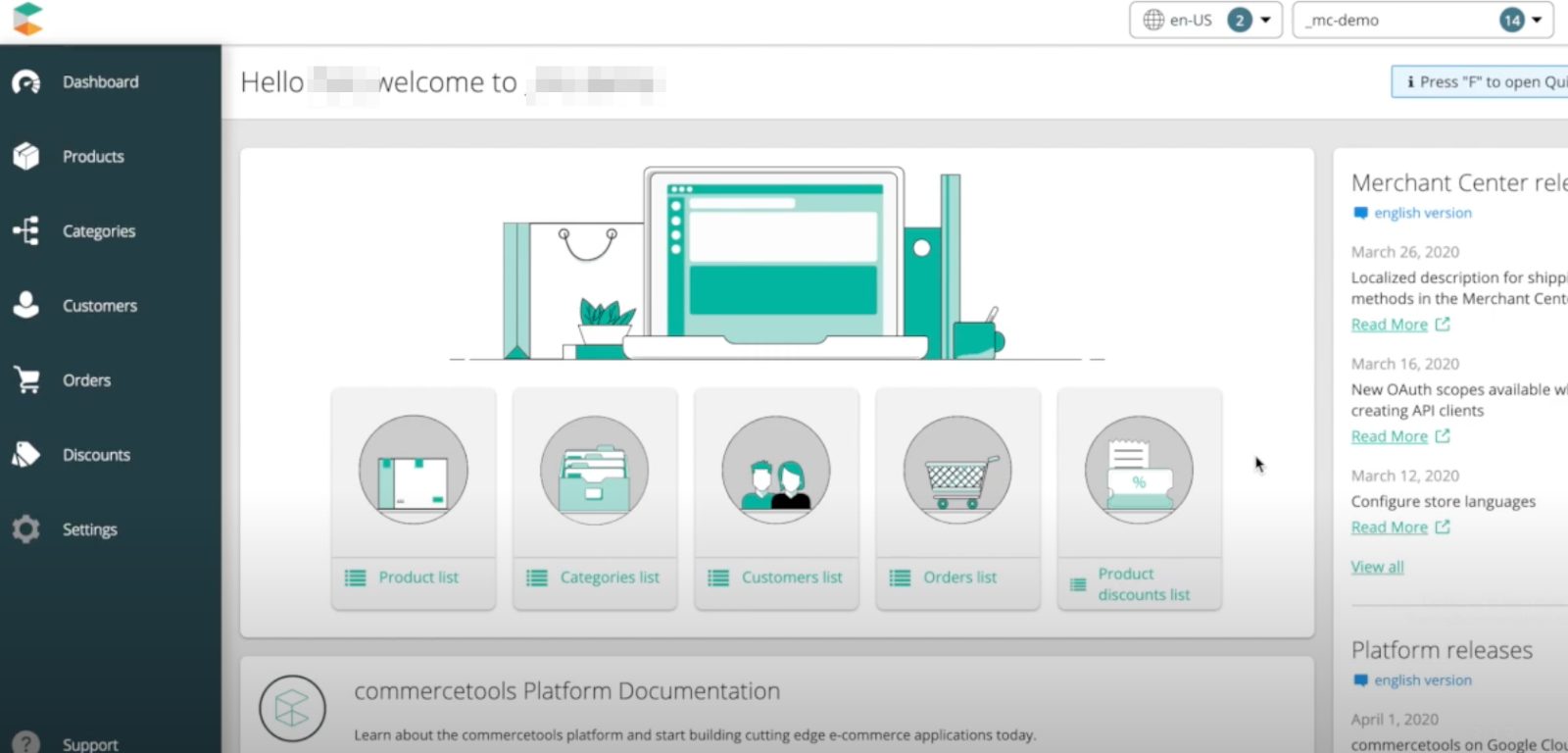
What Kinds of Integrations are Available?
Commercetools can be integrated with Contentstack, Cybersource, and Frontstatic, along with front-end CMS systems. More integrations are constantly being added, you can check them here.
Does it Have Good Customer Service?
Commercetools has limited customer service options. There doesn’t seem to be phone or live chat support.
Is it Customizable?
Commercetools can be customized using APIs. These helpful tools allow you to create custom fields, including discount codes, categories, customer groups, shipping methods, shopping lists, and more. It allows you to place your own personal spin on these elements of your store, and ensures that you’re not enslaved to a template.
5. Salesforce Commerce Cloud
Salesforce Commerce Cloud is an eCommerce platform created by the popular CRM company Salesforce. It was formerly known as Demandware in the B2C sector and CloudCraze in the B2B world.
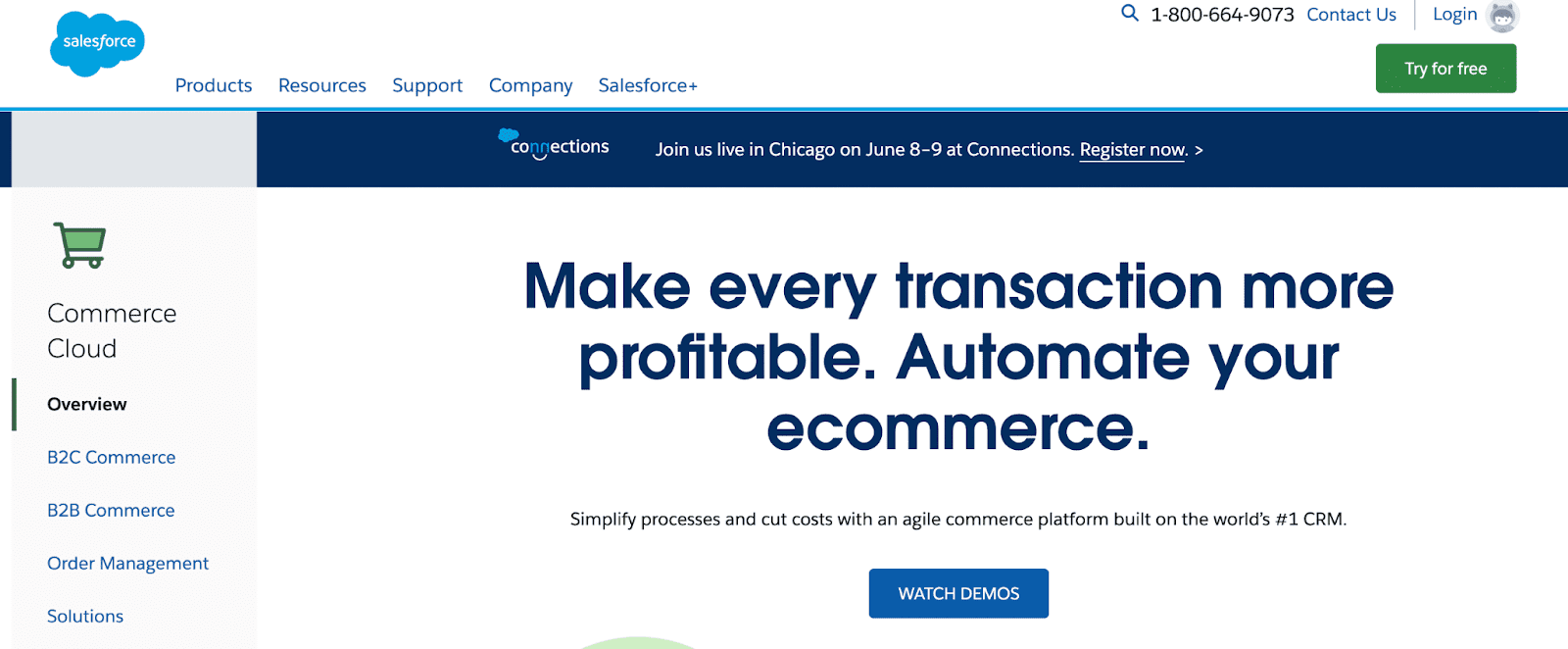
With Commerce Cloud, you can access an agile platform with enhanced security that can grow with your company. A partner app ecosystem is also included, allowing you to integrate with various marketplaces and augmented reality systems.
Of course, being created by a CRM company, you’ll be able to connect your store with your CRM seamlessly. This will help you personalize customer interactions by unifying all of your data. This can, in turn, lead to increased revenue across channels. Commerce Cloud leverages automation and artificial intelligence to help you bring headless commerce to customers.
Pricing for Salesforce Commerce Cloud is available upon request.
What’s the User Interface Like?
The Salesforce Commerce Cloud user interface is relatively easy to use. One thing to note is that it’s a bit more crowded than the other options on this list.
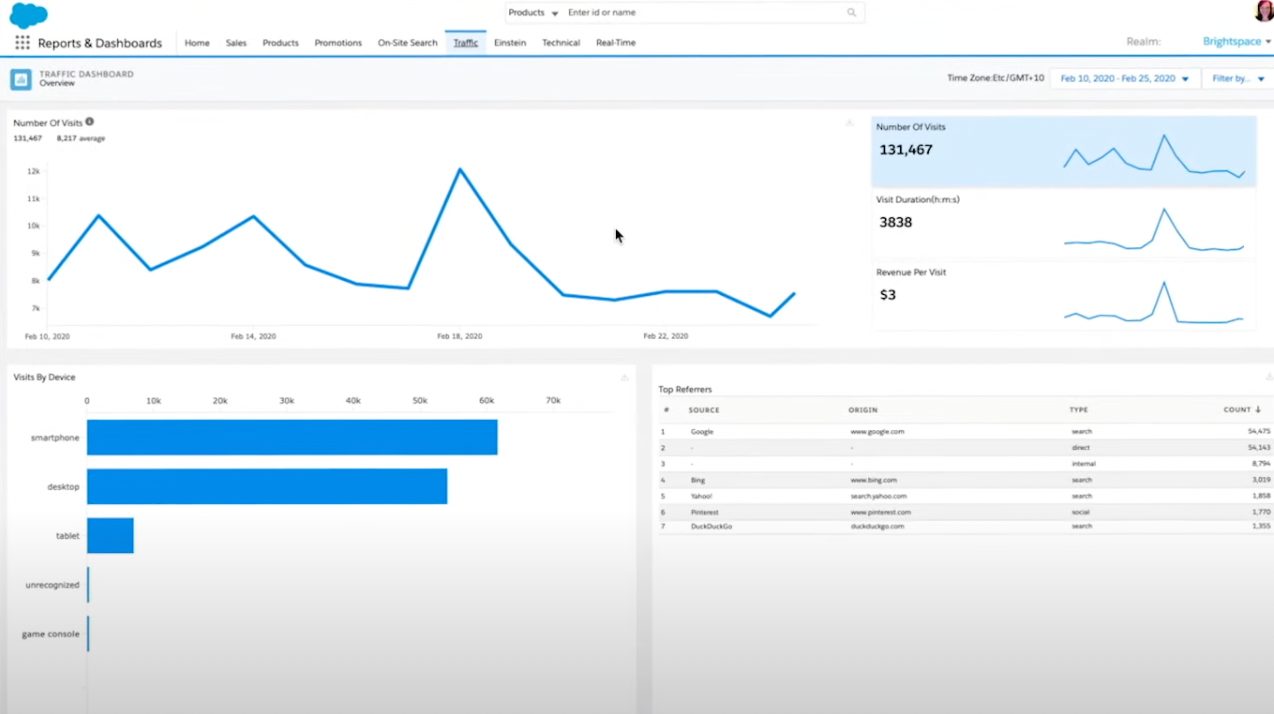
What Kinds of Integrations are Available?
This system integrates seamlessly with the Salesforce family or product, including its popular CRM. It can also be integrated with systems like Slack, along with marketplaces and augmented reality systems.
Does it Have Good Customer Service?
Salesforce Commerce Cloud has live chat and phone customer support readily available. Salesforce has a massive resources page divided into different sections, including but not limited to events, roles, content types, blog articles, and much more.
Is it Customizable?
There is a partner marketplace with links to various services that can help you personalize your store.
6. Spryker
Spryker is a German headless commerce platform that offers solutions for B2B and B2C companies.
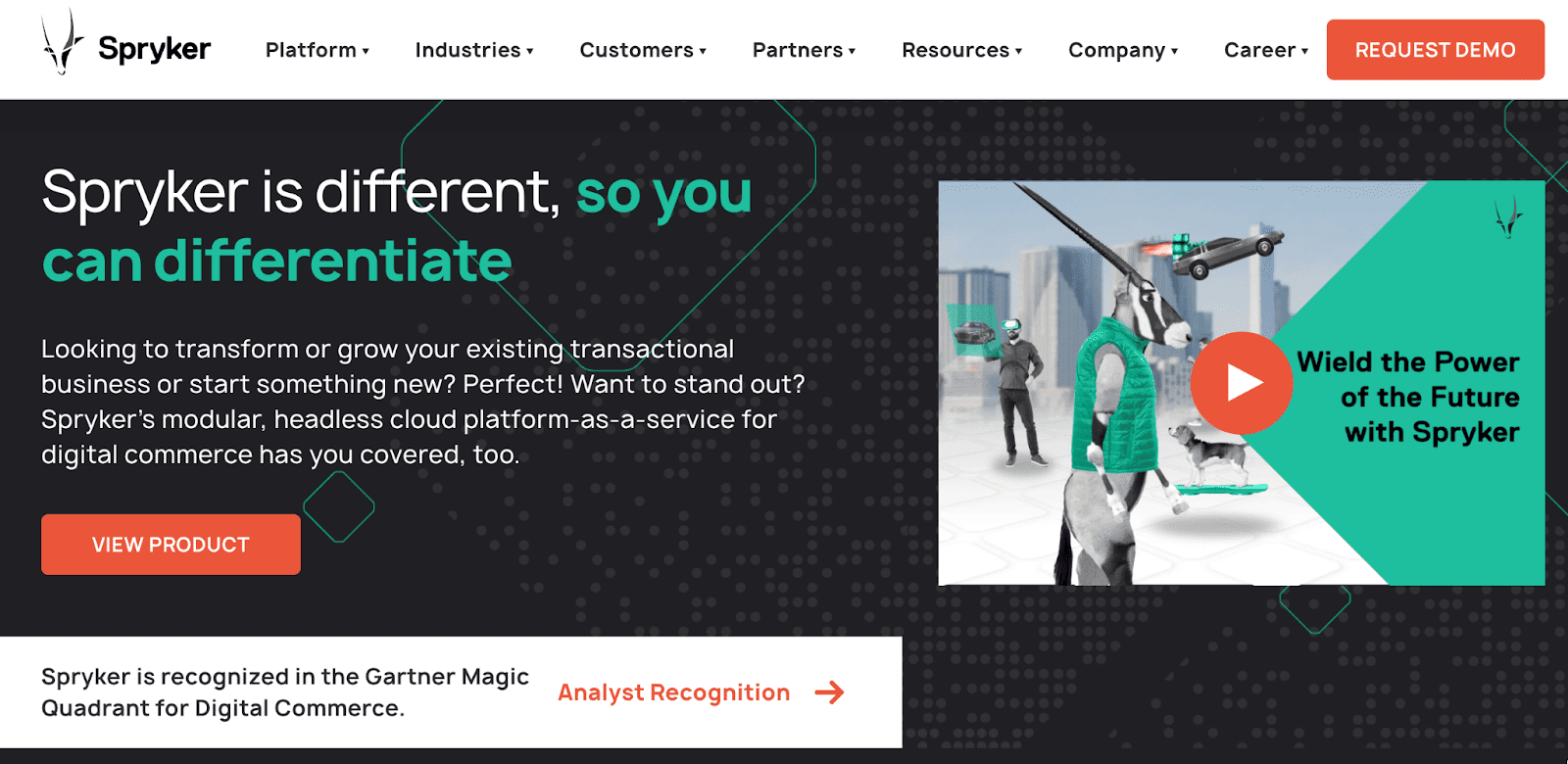
It markets itself as a platform-as-a-service solution, utilizing more than 900 API modules. This is a cloud-enabled service that has become popular with enterprise-level companies. You can use it to scale your company without worrying about technical limits.
That’s why it’s trusted by big-name companies like Toyota, Prym, and Lekkerland. Spryker’s online stores can be built completely from scratch. It even provides expert guidance to help you with this from beginning to end.
The headless commerce experience offered by Spryker works through its GLUE API. It gives you the option to integrate smart devices and large legacy platforms. You can also use IoT touchpoints for eCommerce recurring purchases, which will allow you to more easily retain your loyal customers. This will increase both customer loyalty and your average order value.
Spryker does not make pricing information publicly available. The company offers a demo through its website.
What’s the User Interface Like?
Spryker’s user interface is very simple, showing orders and offers on the homepage. There’s a side menu that’s not overcrowded with too many buttons.
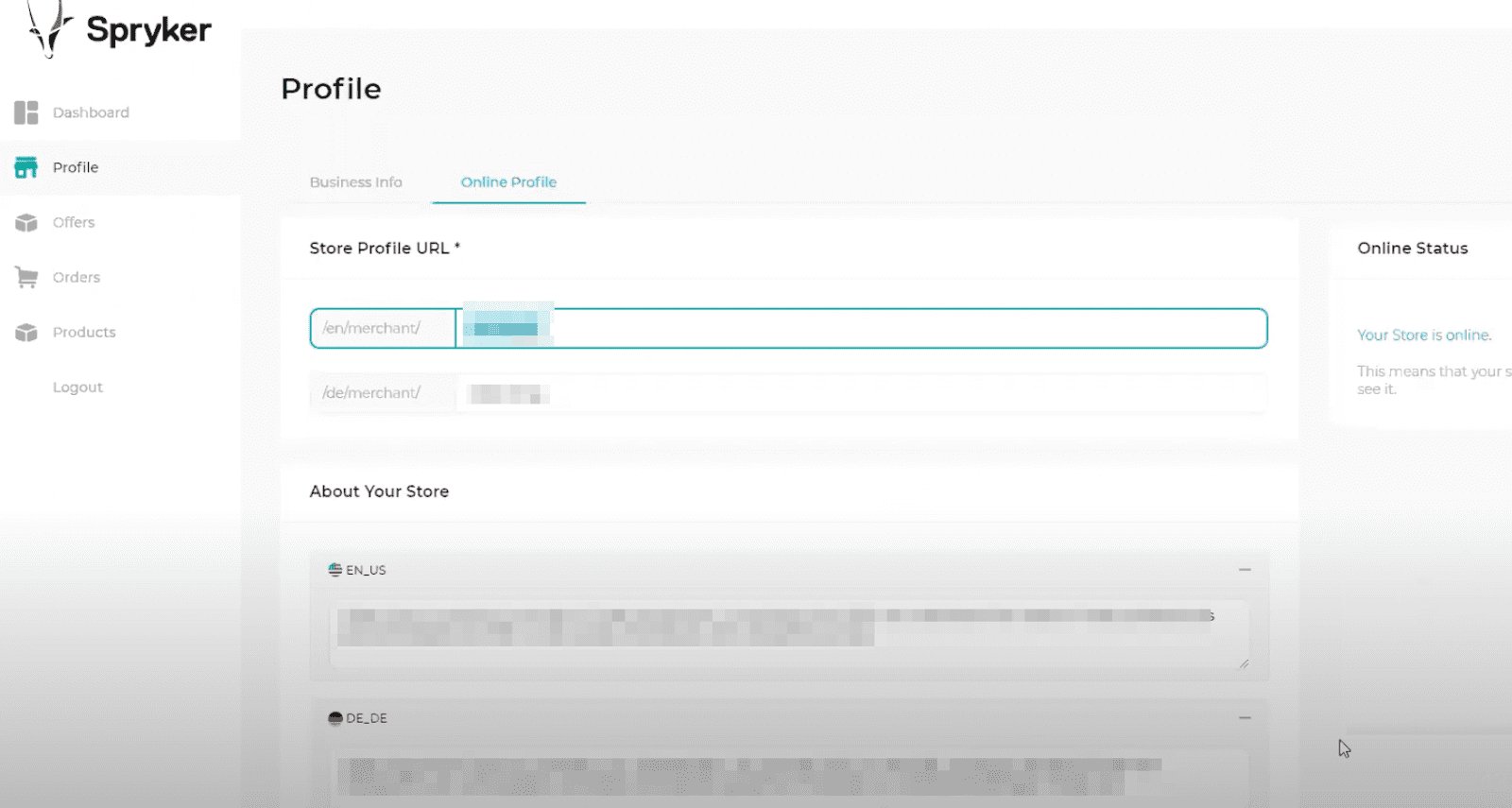
What Kinds of Integrations are Available?
Spryker can be integrated into massive legacy platforms. You can check out spryker’s partners page on its website to see a full list of integrations offered.
Does it Have Good Customer Service?
Spryker’s customer service appears to be limited to a contact form with no phone or live chat support.
Is it Customizable?
Spryker can be customized through its various partner services. For example, Algolia can help you create a customized search function for your store. The PayPal integration lets you add PayPal as a viable payment option. These services give you enhanced flexibility, allowing you to create the headless commerce platform that you envision.
7. Infosys Equinox
Infosys Equinox is a US-based headless commerce company that combines human-centric commerce with marketing. This, in turn, creates a very personalized experience across various touchpoints and channels.
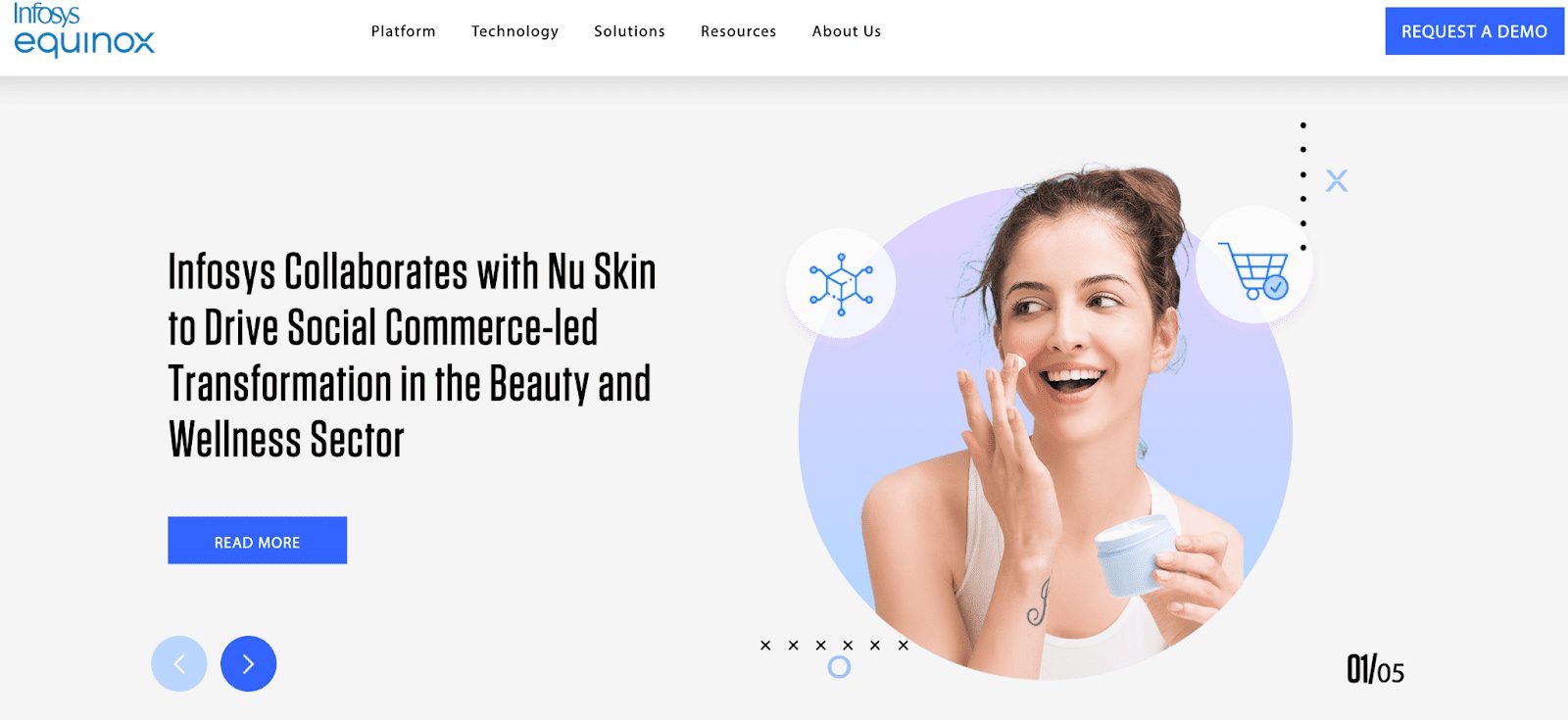
Its website claims speeds reaching up to 30% faster than competing commerce solutions. The service integrates seamlessly with social media platforms, messengers, voice services, chatbots, augmented reality, virtual reality, IoT devices, apps, and wearable devices.
It works with more than 25 technology partners worldwide, including CMS solutions, tax and shipping providers, payment gateways, and more.
Solutions are available for B2B, B2C, D2C, and B2B2C business models.
Pricing is available upon request, and the company offers demos through its website.
What’s the User Interface Like?
The customer-facing user interface for this service is clean and simple
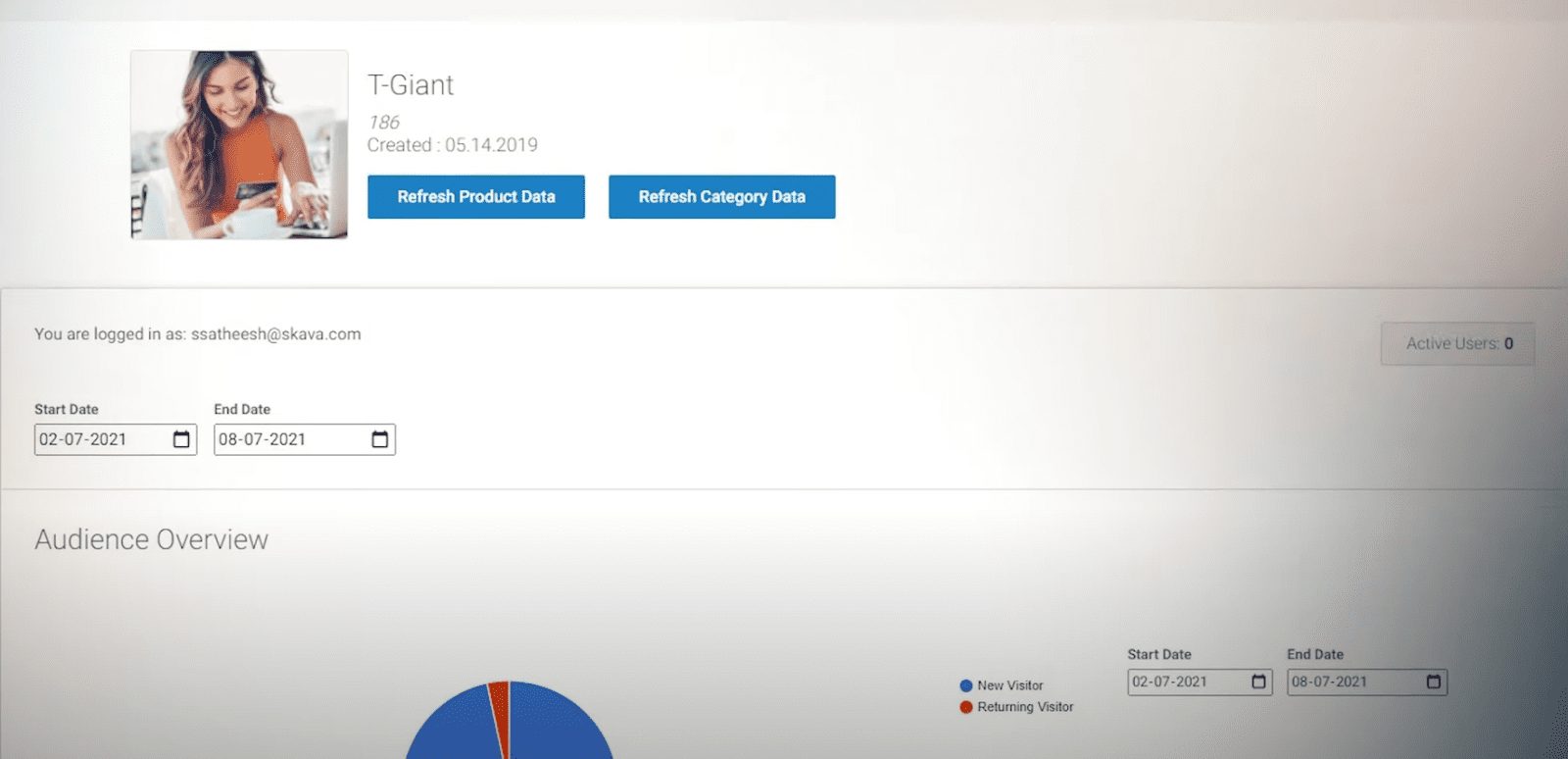
It can be personalized to the user’s preferences. The backend user interface is open, easy to use, and contains personalized reports at the push of a button.
What Kinds of Integrations are Available?
Infosys integrates with messenger services, voice platforms, social media sites, chatbots, VR and AR, IoT devices, and wearable technologies.
Does it Have Good Customer Service?
There is no phone number or live chat support. Infosys uses a contact form for outreach.
What Learning Materials are Available?
The resources page features articles, ebooks, videos, and information about important members of the staff.
Is it Customizable?
Infosys Equinox can be personalized across various channels and touchpoints. It boasts “hyper-personalized” experiences.
8. Swell
Swell is a US-based headless commerce platform specializing in customer experiences and unique business models. The main goal of Swell was to create an easy-to-operate headless commerce solution that anyone could use. It supports B2C and B2B business models.
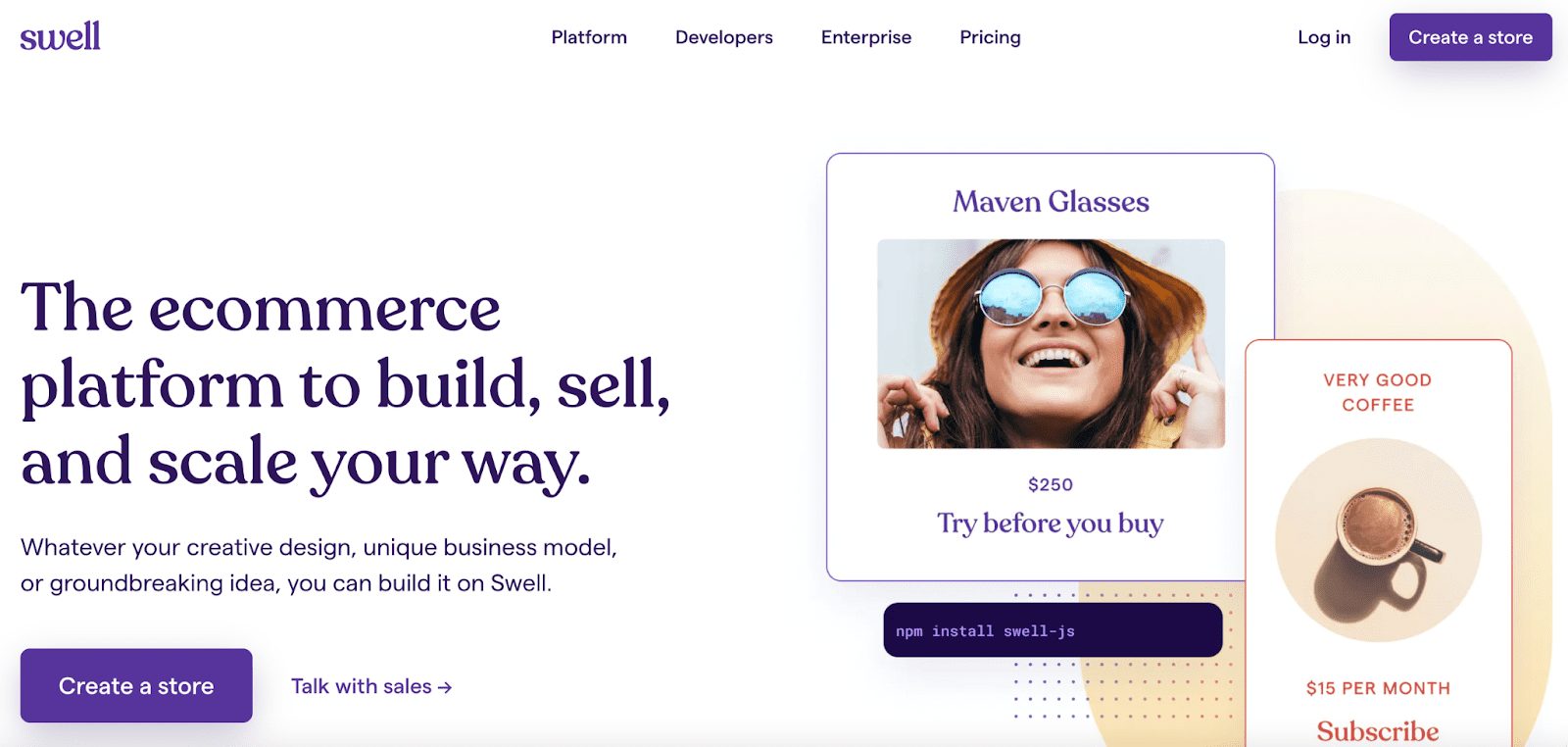
Swell takes an API-first approach to back-end management, using modern development tools to future-proof businesses. This platform can be used by small to mid-size businesses, but it can also be a great option for massive enterprise organizations.
Swell’s ease of use is one of its best features, allowing you to manage everything from an intuitive central dashboard. It’s an interface that’s simple enough for new users to master with customizable elements that more advanced users can take advantage of.
Users can manage product options, including variations in size and color, with a simple click. No plugins or coding are required for product option updates, making this a more streamlined experience. With the APIs offered through Swell, users can create custom checkout flows to create the shopping experience they envision for their customers.
Many integrations are available with services like Stripe, PayPal, Braintree, Zapier, Slack, Mailchimp, Algolia, and ShipStation.
Swell has a limited free option. Paid plans start at $299 per month, with an Enterprise plan hitting $2,000 per month.
What’s the User Interface Like?
Swell has a clean user interface that’s easy to use and understand.
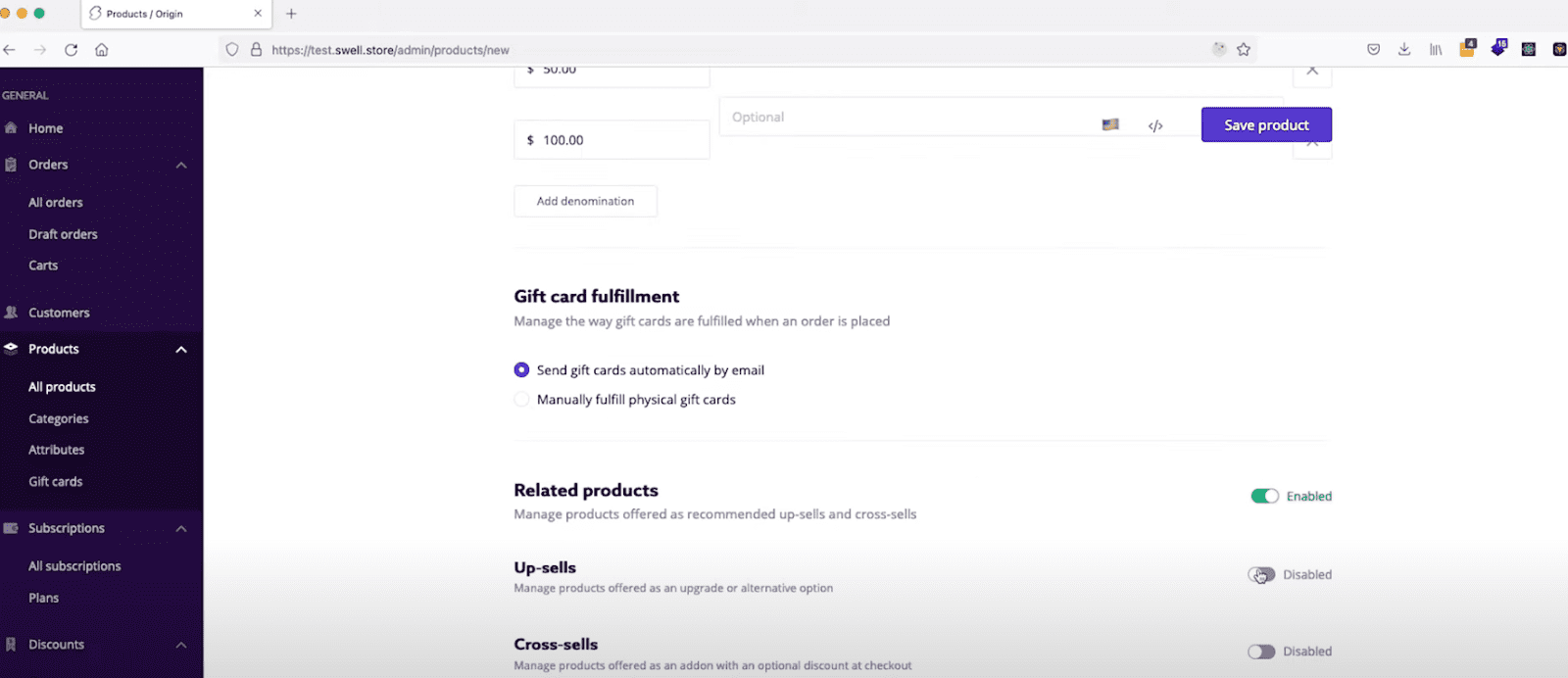
It has a side menu and doesn’t bog you down with too many options.
What Kinds of Integrations are Available?
Integrations are available for Stripe, Braintree, PauPal, Zapier, Mailchimp, Slack, Algolia, ShipStation, and many more quality services.
Does it Have Good Customer Service?
Swell’s customer service is limited to a Help Center.
What Learning Materials are Available?
The Help Center has articles, frequently asked questions, and a search function. There’s also a resources page and a community forum.
Is it Customizable?
You can create a completely customized checkout flow using Swell.
9. OroCommerce
OroCommerce is a headless commerce platform that’s popular with wholesalers. It was actually built by the same leadership team that created Magento, so you know it’s coming from quality minds.
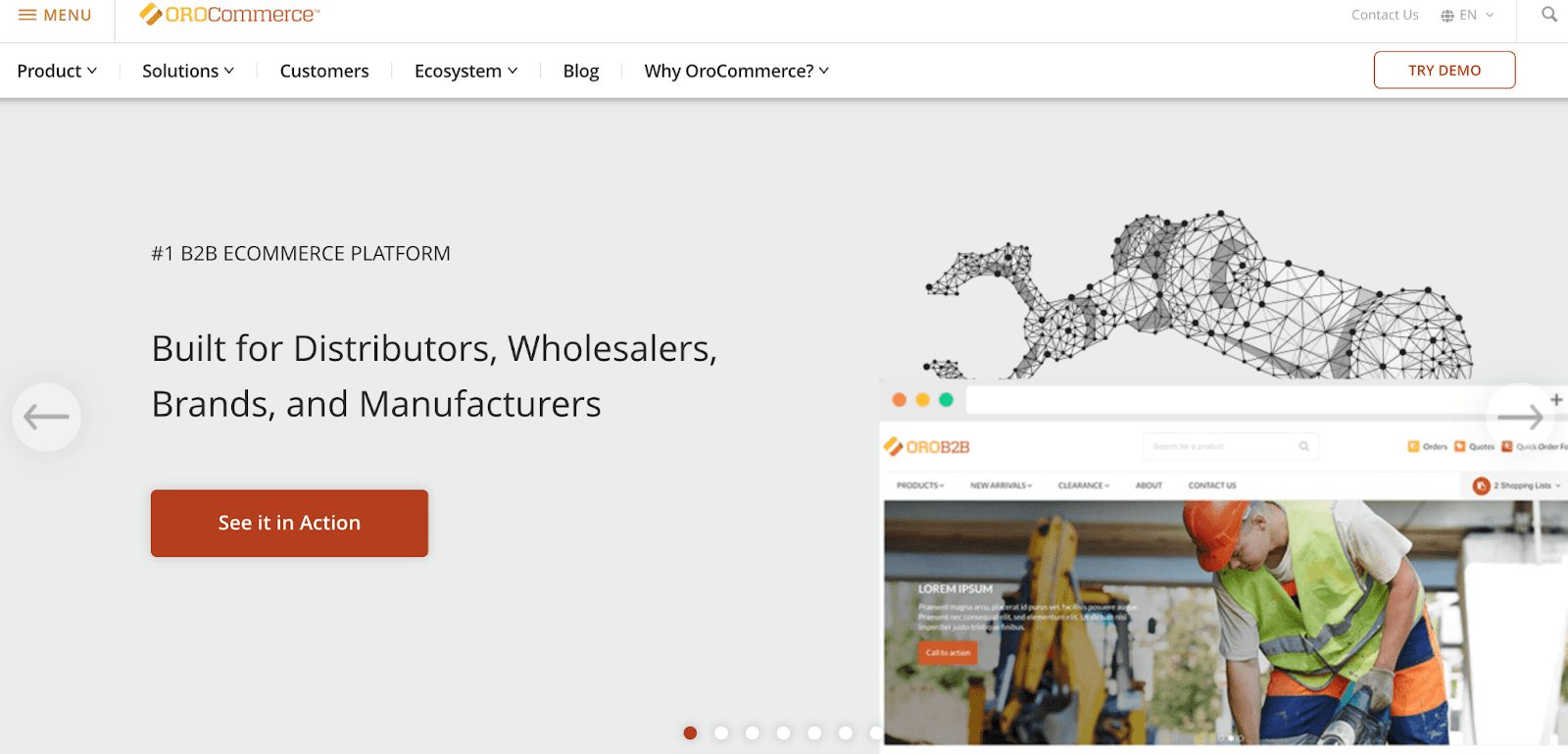
OroCommerce was specifically designed for the B2B industry. However, thanks to advanced customization options, it can be used for B2C, B2B2C, and B2B2B models as well. Thanks to the inventory management solution offered through this platform, you can manage multiple websites and warehouses while managing your product catalogs and adjusting prices at will. It can be deployed either on-premise or via the cloud.
This product also comes with a built-in CRM that helps with sales pipelines, customer segmentation, marketing, sales projections, and more throughout your entire business. If you already have a CRM, it will integrate with many CRM apps and ERP solutions.
You’re able to choose between headless commerce and a traditional eCommerce platform when using OroCommerce, ensuring that you’re able to create the exact store you want. The company takes an open-source approach, creating a developer community around the product. This provides code transparency, product reliability, and enhanced security.
Pricing for OroCommerce is available on request.
What’s the User Interface Like?
The user interface for OroCommerce is simple and clean.
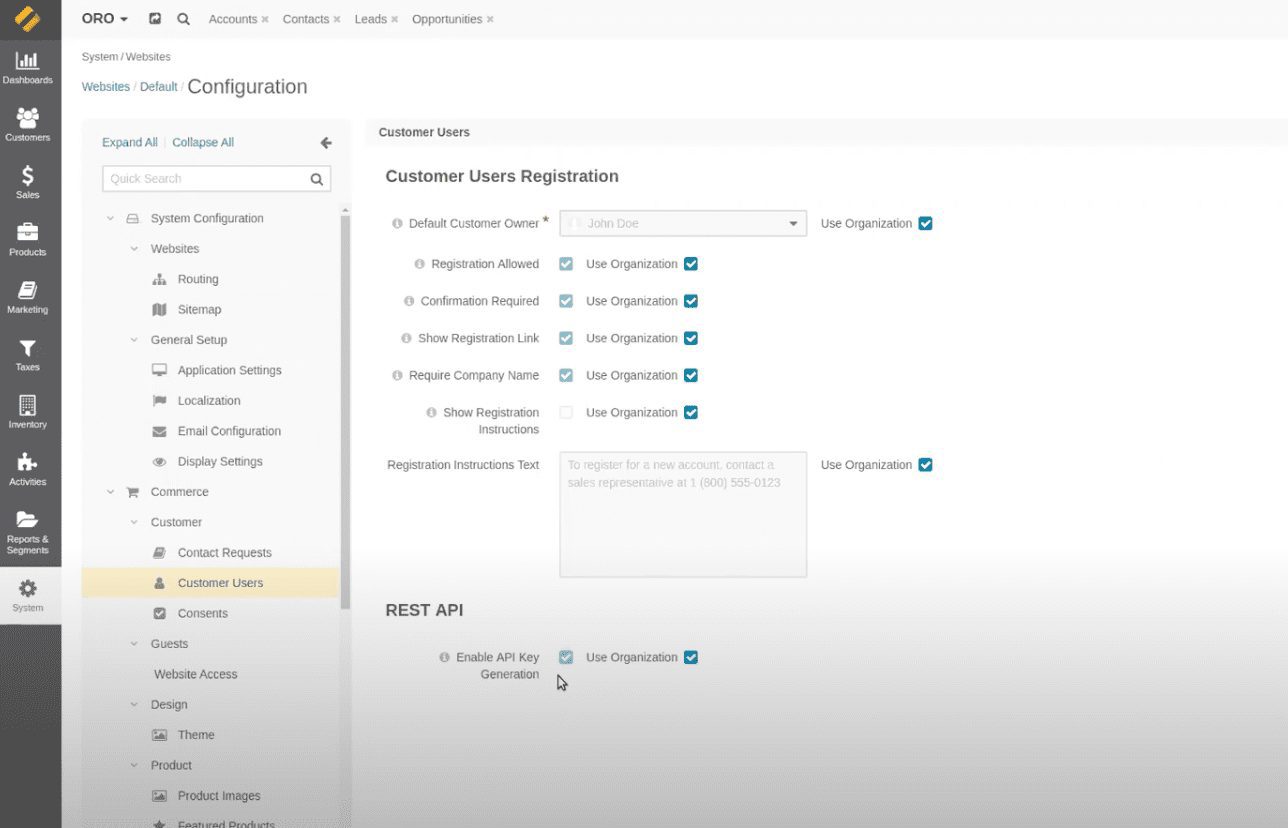
It features a side menu that has ten options to choose from.
What Kinds of Integrations are Available?
OroCommerce integrates with systems like CRMs, ERPs, PIMs, and payment systems.
Does it Have Good Customer Service?
OroCommerce runs customer service through a ticketing system and is available Monday to Friday.
What Learning Materials are Available?
This service has a learning center with articles, whitepapers, podcasts, and more.
Is it Customizable?
With OroCommerce, you can create a fully customized ecommerce website.
10. Nacelle
Nacelle is a headless commerce platform that allows you to create a headless architecture with the tech stack you’re already using. That means it doesn’t require any migration to work.
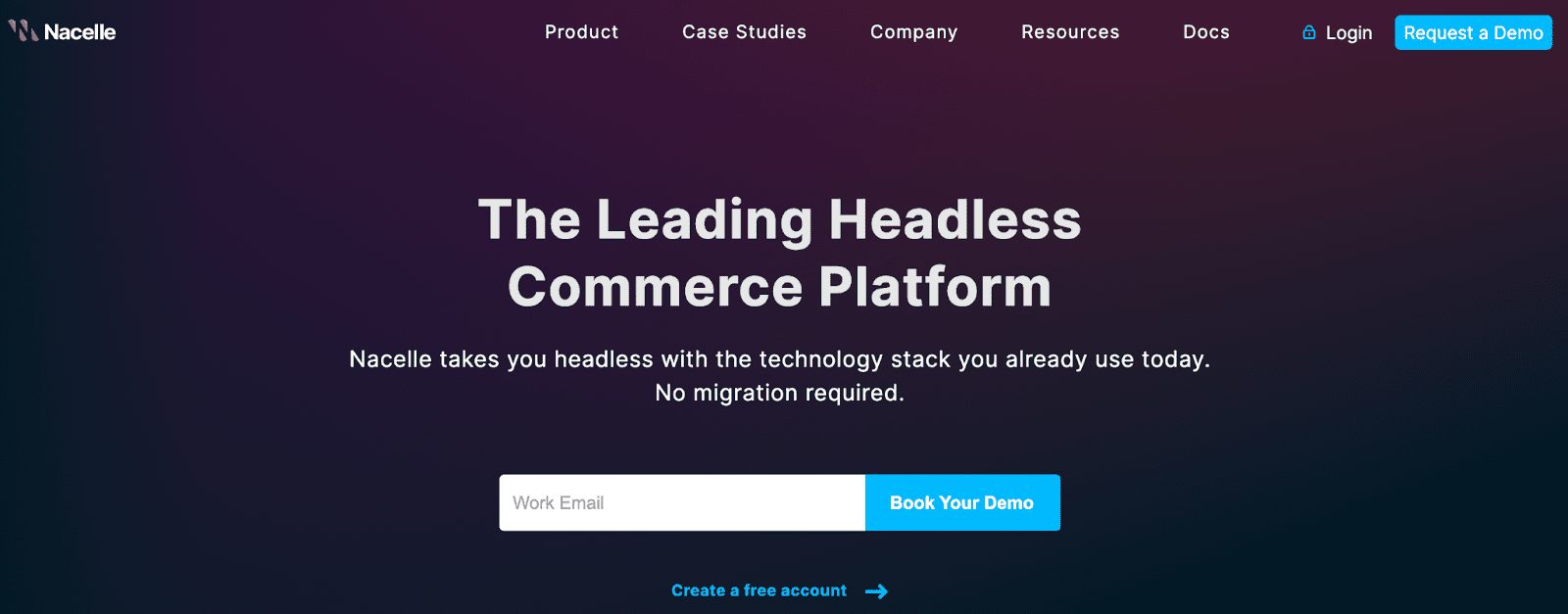
It does this by collecting data from your system and joining it with your content and stores in a manner that perfectly fits headless development. The system re-indexes everything to make the data more durable. It can collect data from other platforms like SalesForce, Netsuite, Magento, and Shopify. This extends to other CMS, PIM, and OMS systems as well. It can also gather data from custom-built platforms.
The data is delivered using a GraphQL API specially optimized for builds using a progressive web app. Thanks to Nacelle’s transcript SDK and React/Vue starter kits, data continues to flow.
Nacelle offers pre-built integrations with Sanity and Contentful. This comes with templates that will allow you to build a PWA app in under five minutes. While those integrations are built-in, you’re not limited to them. Developers can integrate Nacelle with any CMS of their choice.
What’s the User Interface Like?
Nacelle has a high ease of use and integrates into an existing tech stack.
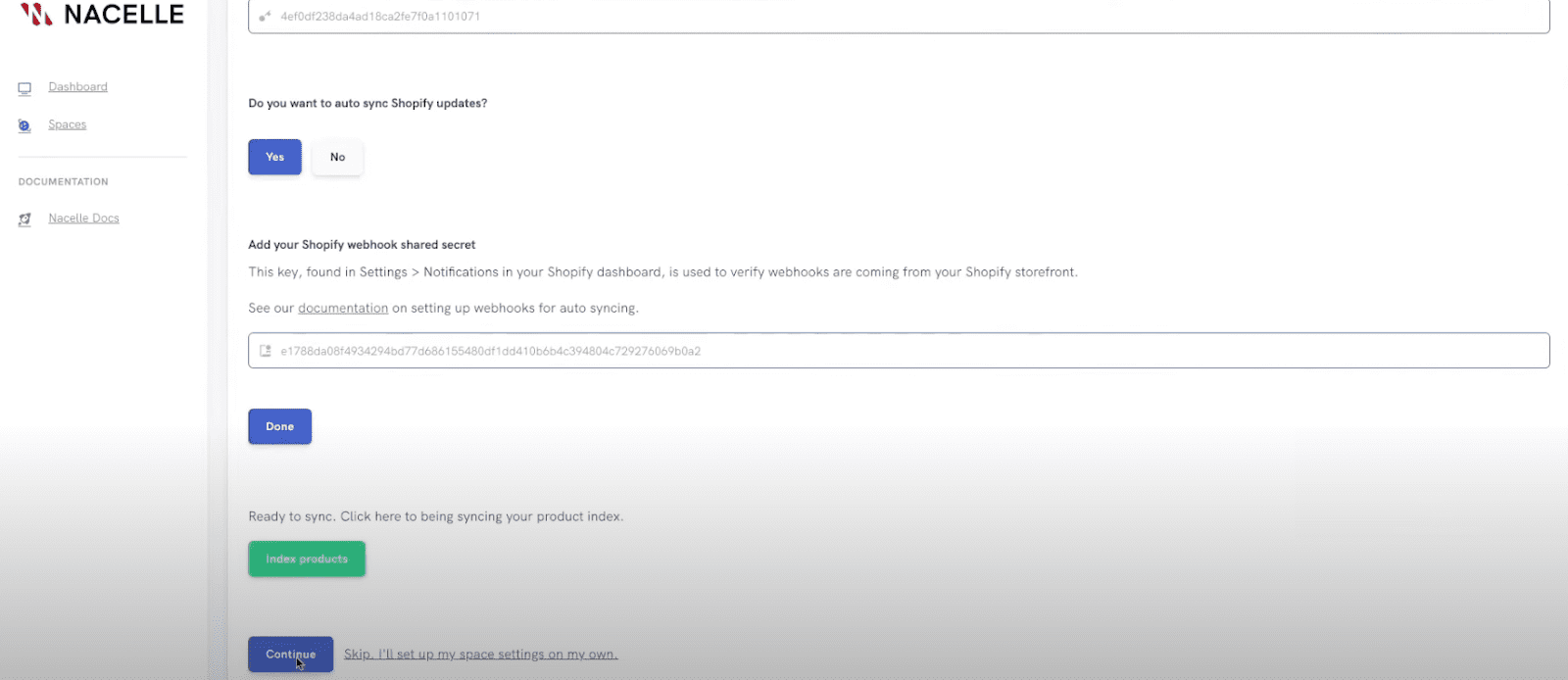
What Kinds of Integrations are Available?
Nacelle can be integrated with any CMS and comes with pre-built integrations with Contentful and Sanity.
Does it Have Good Customer Service?
Nacelle’s customer service options listed on its website seem to be a help center with frequently asked questions. There is a contact page with a contact form.
What Learning Materials are Available?
Nacelle has a blog, guides, webinars, and frequently asked questions on its resources page.
Is it Customizable?
Nacelle can be customized to fit in with an existing tech stack.
11. Commerce Layer
Commerce Layer is an Italian headless commerce platform that doubles as an order management system. It allows you to easily add global shopping services to websites, chatbots, mobile apps, and IoT devices. Beginners will have no issues using the headless eCommerce solutions offered by this service.
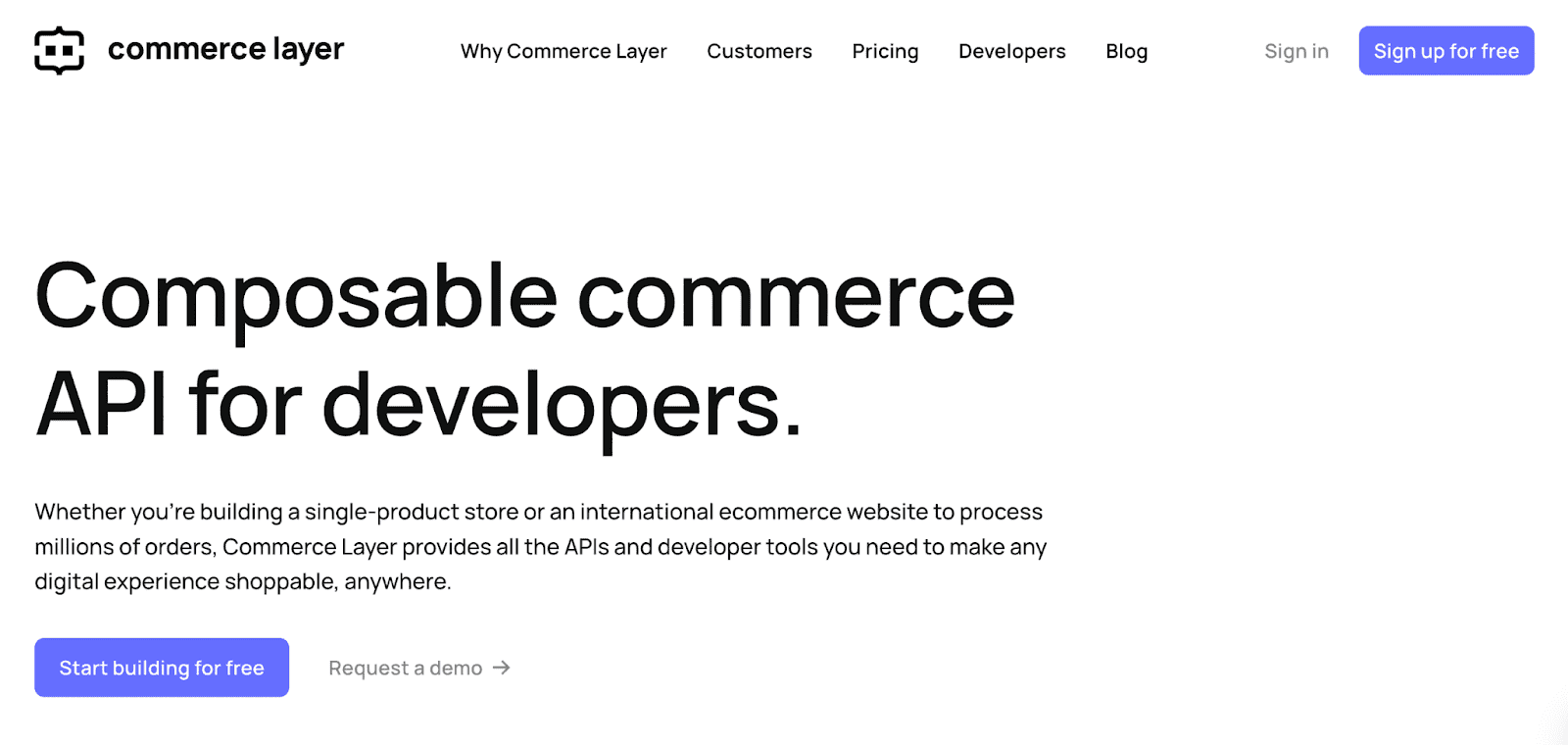
This is a headless commerce option for everyone. Small stores that sell a single product will get great use out of this service, while it’s also great for huge enterprise companies that need to process millions of orders.
This service uses over 300 API endpoints and has a guaranteed uptime of 99.99%. You can integrate any third-party service into this platform thanks to its composable architecture.
Commerce Layer is designed to be headless right out of the gate, making it easy to implement this architecture into your store. It does this through omnichannel experiences, custom interfaces, a unified market hub, and a customer-friendly API microservices architecture.
Content Layer offers a limited free plan, with its premium Growth plan costing $649 per month. There is also a custom Enterprise plan, but you’ll have to contact Content Layer for pricing.
What’s the User Interface Like?
Commerce Layer has a simple user interface that’s easy to use.
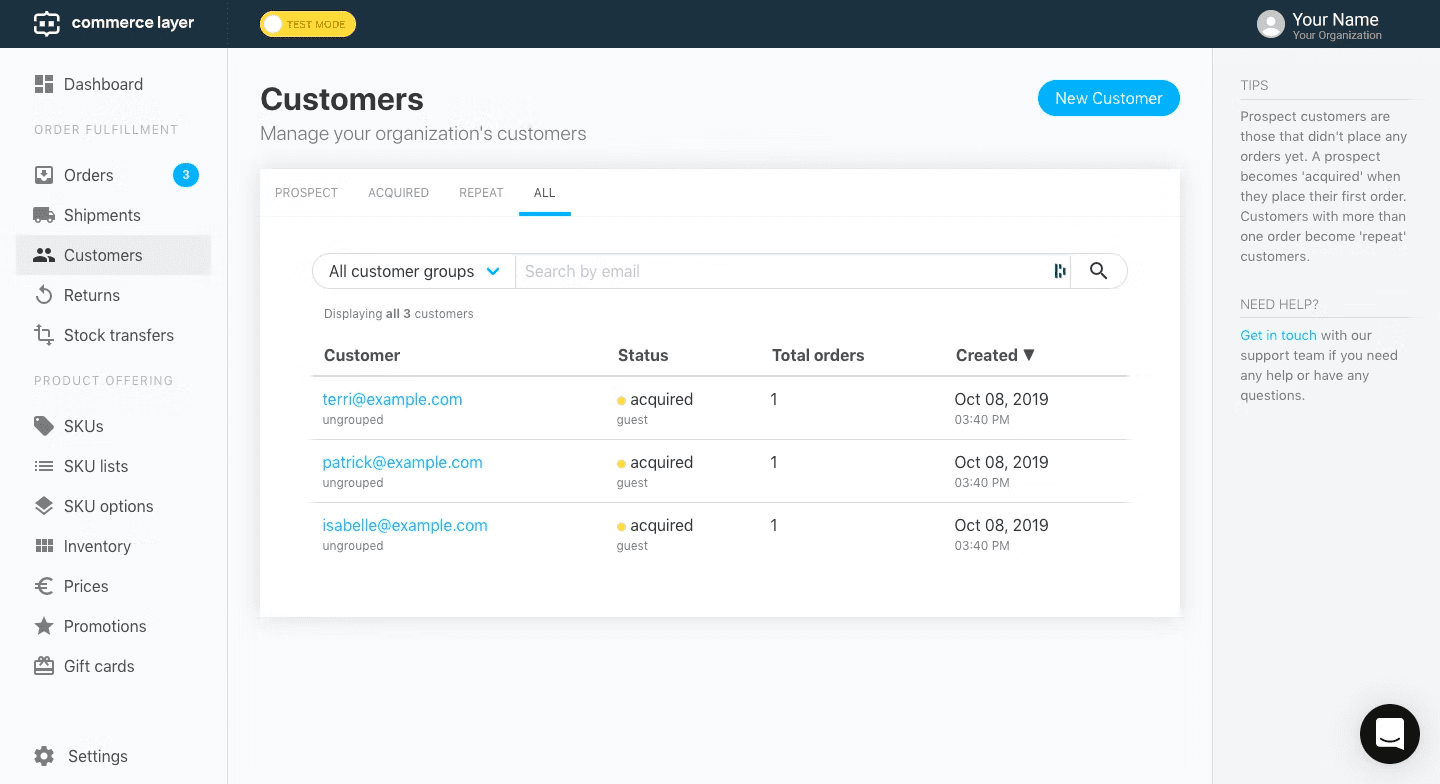
There’s a side menu available that lays everything out in an easy-to-understand manner.
What Kinds of Integrations are Available?
You can use Commerce Layer to integrate your point of sale system. Its composable architecture makes it easy to integrate with third-party solutions.
Does it Have Good Customer Service?
Support can be contacted through email only.
What Learning Materials are Available?
There is a resources page that features various white papers, API reference guides, and more.
Is it Customizable?
This headless commerce platform includes customizable interfaces that allow you to make the entire experience your own.
12. Fabric
Fabric is an American headless commerce platform built specifically for business growth. It has served some massive clients, like GNC, UniversalLacrosse, ABC Carpet & Home, and more. You can use Fabric to create an ideal online shopping experience by connecting your sales channels with the platform.
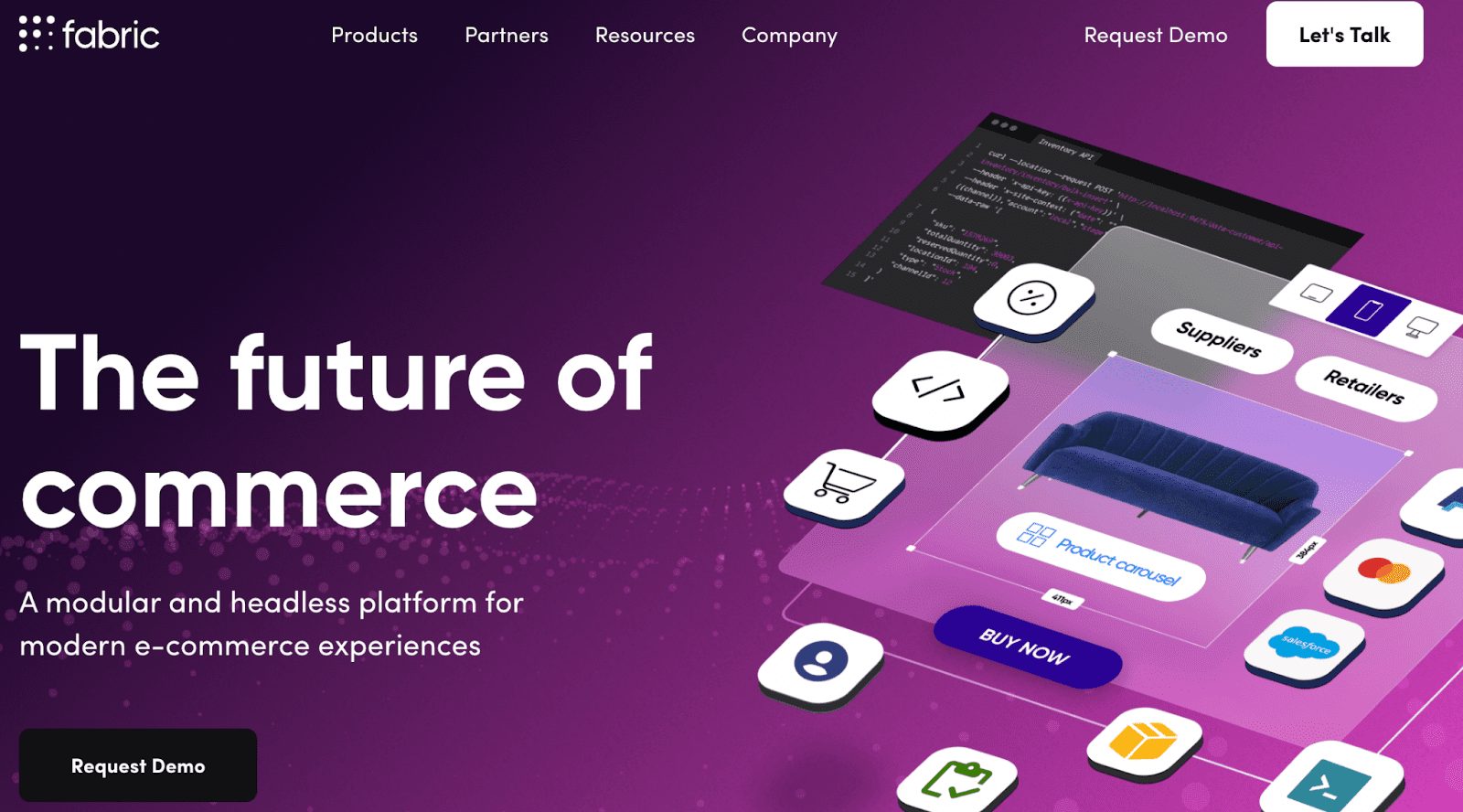
This will allow you to connect your pricing, order data, and product information with every channel in your arsenal and create new experiences for new channels. You’ll also be able to update every sales channel connected to your eCommerce website at once from one central location.
Fabric integrates with third-party tech along with custom-built platforms. You can use Fabric to create a monolithic tech stack for a growing customer base. Its full suite of headless APIs allows you to create custom, unique shopping experiences across an infinite number of channels.
The extensible APIs offered by Fabric will let you add your own logic, and the composable architecture of the platform makes for simple integrations. The more than 300 API endpoints you can access with this service have a response time of under 50 ms, making it lightning fast.
Some of the APIs offered include:
- Order
- Product
- Inventory
- Shipping
- Promo
- Cart
Contact Fabric for pricing information. The company offers a demo that you can sign up for on its website.
What’s the User Interface Like?
The user interface for Fabric is simple and easy to use.
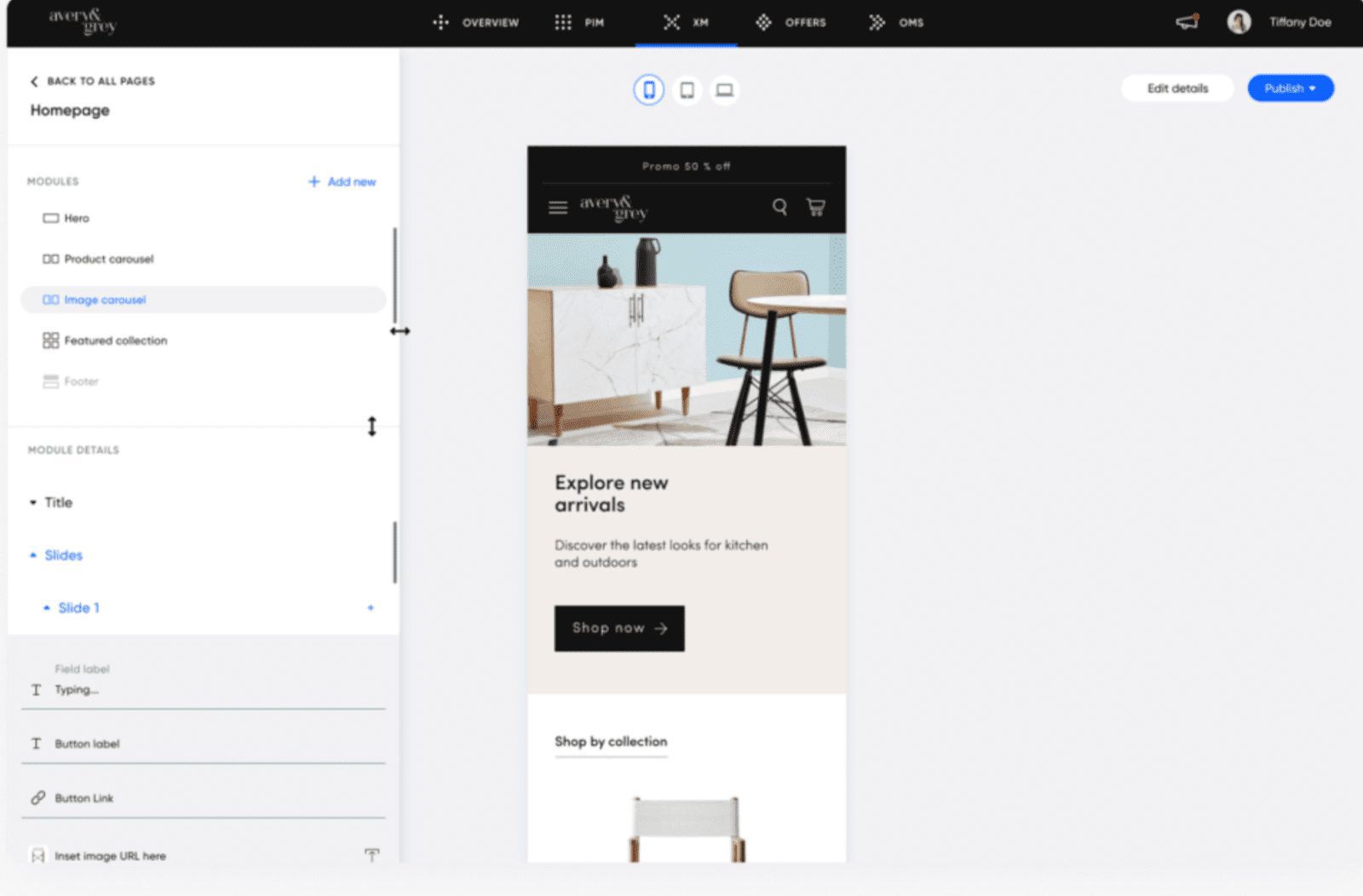
It’s very open and clean, with no confusing elements.
What Kinds of Integrations are Available?
Fabric’s composable architecture makes integrations a simple matter. It has a partners page with a wealth of integrations.
Does it Have Good Customer Service?
There is a live chat feature. The customer support page features a search bar that will help you find the information you need.
What Learning Materials are Available?
There is a resources tab in the top menu with a full knowledge base and API docs. There’s also a blog with helpful and informative articles.
Is it Customizable?
The full suite of headless APIs available with Fabric allows you to create custom shopping experiences.
Headless Commerce FAQs
What Is a Headless eCommerce Platform?
A headless eCommerce platform is an online store where the customer-facing front-end and technical back-end are decoupled from one another. This gives you the ability to update these different elements of your store without having to change the other.
What are the Benefits of a Headless eCommerce Platform?
The main benefit of using a headless eCommerce platform is that it allows for advanced customization of both the front and back ends of your store. It also allows you more time to focus fully on the user experience because you don’t have to spend time creating business logic and back-end services.
It also provides fast and simple integrations, allowing you to connect the tools you love and trust, using APIs to communicate between software platforms and transfer data.
Is Shopify Headless eCommerce?
Yes, Shopify allows for a headless eCommerce setup. You can use third-party apps to build out your store’s front-end as you see fit while also using the Storefront API to customize your checkout flow and shopping cart system.
Is Magento a Headless eCommerce Platform?
Yes, Magento has allowed for a headless commerce architecture since version 2.3. It does this by allowing you to use GraphQL as an API. Before version 2.3, headless commerce was still possible using Magento, but you had to utilize custom API solutions to make it happen.
Conclusion
We spent a lot of time highlighting 12 of the best headless eCommerce platforms in the world. The solutions we’ve covered today offer tremendous value, eCommerce functionality, and optimization opportunities that can help you design the ultimate eCommerce digital experience.
Whether you’re looking for B2C or B2B eCommerce, there’s a headless commerce solution that will meet your business needs.
To review, we feel that the 12 best headless commerce platforms out there are:
- Shopify
- Magento
- BigCommerce
- Commercetools
- Salesforce Commerce Cloud
- Spryker
- Infosys Equinox
- Swell
- OroCommerce
- Nacelle
- Commerce Layer
- Fabric
These services will allow you to develop custom front-end and back-end solutions for your customers, keeping your store relevant to their needs by following the headless approach.
If you want to bring headless commerce solutions to the world of subscription-based revenue, contact Chargebee today for a demo.




